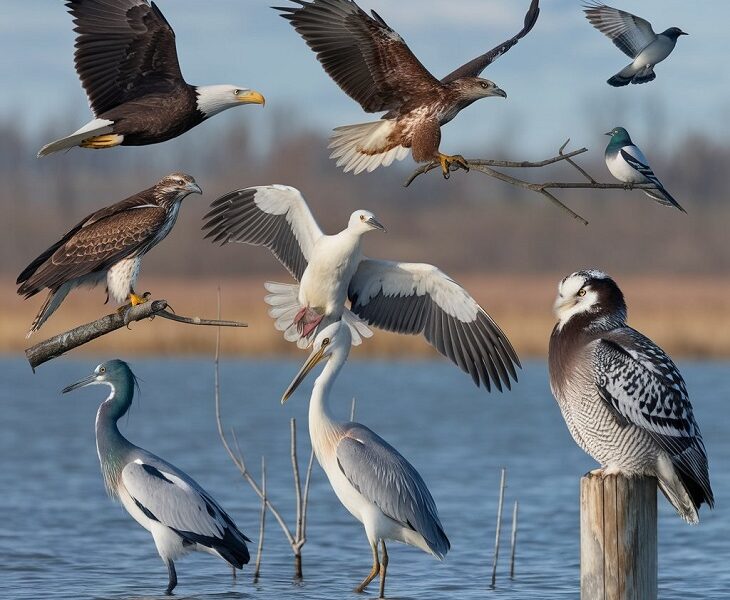Aerial animals are those that can fly or move through the air on their own using different bodily adaptations, such as wings or feathers. Their ability to move through the air does not mean that their habitat is there, but rather that they combine several territories to survive.
Some aerial animals have wings that allow them to move through the air and continue flying for a long time (controlling their direction , speed and height). Others move through the air but with less control over their flight (so they cannot fly very long distances). There are also aerial animals that can glide, despite not having wings, and they do so thanks to the anatomical shape of their body.
For some aerial animals, flight is the only way to get around. Within this group, different species can fly, but this ability depends on their anatomical structure and survival needs. . For example, some can fly great distances (to migrate and avoid very low temperatures during the winter or to search for food ) and others can only move for a few moments in the air (to defend themselves from predators or hunt their prey).
Types of air animals
Air animals can belong to the following groups:
-
Birds.
- Birds are warm-blooded vertebrates characterized by bipedalism, the ability to make short jumps, and sometimes walking. They have a light skeleton, wings, and bodies covered with feathers that provide protection against low temperatures, wind, humidity, and intense sun. Their adaptations for flight include light bones, specialized feathers that increase wing surface area, powerful pectoral muscles, and efficient circulatory and respiratory systems that support a high metabolism.
- While most birds can fly, some, like penguins and ostriches, cannot.
All birds are oviparous, that is, they reproduce by means of eggs that the females lay and incubate until the offspring are born. In addition, they all have beaks instead of mouths, and their diet is very varied, depending on the species. -
Insects
- . They are invertebrate animals , that is, they have an exoskeleton that supports the organism. They usually have three pairs of legs, two pairs of wings and antennae, which serve as the main sensory organ through which they experience touch, smell, hearing and the sense of orientation.
- Their wings are located on the thorax and are composed of light membranes, although in some cases they are colored . Some insects do not use their wings to fly, but to attract the female during courtship. There are also others in which the wings are not even present.
The reproduction of this group is mainly oviparous and sexual, although there are some cases of asexual reproduction . As for their diet, they can feed on both plants and other smaller insects and even remains and waste. -
Mammals
- . The only mammal capable of flying is the bat, or chiropter, a warm-blooded vertebrate animal with four limbs. It also has a thin membrane of elastic skin between its limbs, called a patagium, which allows it to support itself during flight and move through the air.
Bats are viviparous , meaning they do not lay eggs. Instead, their offspring develop in the female’s belly until they are born. As for their diet , they mainly eat fruits and insects.
Gliding animals
- . This is a group of animals that, although they do not have the ability to fly or make controlled movements , can travel short distances, taking advantage of air currents as a means of transport. They are characterized by being small and light animals, with little body fat, and by having an extension of skin (similar to that of bats) that they use as a “parachute”. An example is flying squirrels, which can jump between trees and glide until they reach another nearby plant. It is also possible to find examples of gliding reptiles, such as some species of lizards and even snakes.
Characteristics of air animals
Aerial animals are mainly characterized by being able to fly using their wings, through propulsion in the air . These wings are covered with feathers in the case of birds, and are made up of silky membranes in the case of insects. There are also some animals that have wings and cannot fly.
In addition to wings, the bodies of aerial animals have other modifications that allow them to fly and move through the air. For example, birds have light skeletons, feathers (which increase the surface area of the wings), strengthened pectoral muscles and cardiovascular systems that allow them to have a high metabolism (in accordance with the high energy consumption during flight).
The type of reproduction is generally oviparous
, that is, by means of eggs that are deposited in the external environment (such as on the ground, in the heights of trees or on the edge of the water ). The exception is bats, which are mammals and, therefore, viviparous. Regarding their habitat , aerial animals do not live exclusively in the air , but also live on land or in water. For this reason, they can feed on seeds, fruits, worms and carrion, among others.
Examples of aerial animals
Some examples of aerial animals are:
The hummingbird
- also known as the “hummingbird”, is the smallest bird in the world, within the group of vertebrates. Its wings can move between twenty and one hundred times per second and, when the male wants to impress a female, he can beat his wings up to two hundred times per second. It is the only species capable of flying in all directions and even levitating in place.
The cockatoo
- The bird considered very intelligent and is distinguished by its peculiar yellow crest of feathers. It has an anatomy similar to that of the parrot, due to the shape of its beak and legs, but its feathers are white. It lives in Australia, Indonesia, Puerto Rico and New Zealand. Its type of reproduction is monogamous, it stays in pairs in the same nest for more than four years and likes to fly in groups.
The eagle
- They are largest predatory bird, and with its powerful claws and strong muscles it can catch prey of the same weight and take flight. It can fly up to two hundred kilometres per hour and, thanks to its excellent vision, it can see its prey from two thousand meters away. Females are larger than males, their type of reproduction is monogamous and they stay together for several years.
The toucan
- This exotic species features a thick, long, and colorful beak used for defense and feeding on tropical fruits, insects, lizards, and eggs. Native to tropical areas of America, it remains sedentary, spending its entire life in the same region without migrating. It typically lives in pairs. is monogamous) or in flocks of about six members.
The flamingo
- It lives in tropical areas, near salt water. The color of its plumage varies according to the species, but pink predominates. It feeds on algae, larvae, insects, crustaceans , mollusks and small fish. It is very sociable and communicates with its own species (especially its offspring) through nasal sounds .
The ladybug
- is an insect belonging to the group of arthropods , of the invertebrate type , also known as the “ladybug”. It has a kind of shell that turns out to be, in reality, a pair of thick, brightly coloured wings (red, orange or yellow, with black spots) that cover and protect its functional wings. During the winter, it usually groups together in groups of ten or fifteen individuals to protect itself from the cold. It feeds on plants, mites, aphids and scale insects, among others.
The flying ant
- . The ant is a very sociable insect that usually lives in large, organized communities underground. Flying ants are those that develop wings only during their reproductive season (an act called “nuptial flight”). They feed on fruits, plants, rotten meat and mainly on a type of fungus that grows on the leaves they collect.
The moth
- this is an invertebrate insect with wings covered in scales. It belongs to the group of “moths” but is smaller and less showy than a butterfly . It is characterized by undergoing a complete metamorphosis , that is, it goes through four stages throughout its life : that of an egg, that of a larva, that of a cocoon and finally that of an adult in the form of a moth (or butterfly). During adulthood, it feeds on the nectar of flowers and lives for a short time, just a few weeks.
-
Conclusion
Air animals, particularly birds, exhibit remarkable adaptations that enable them to thrive in diverse environments. Their unique physical characteristics, such as lightweight skeletons and specialized wings, facilitate flight and survival. Understanding these adaptations highlights the intricate balance of nature and the evolutionary innovations that support life in the skies.
- FOR FERDUR INFORMATION:https://proteomics.uk/




